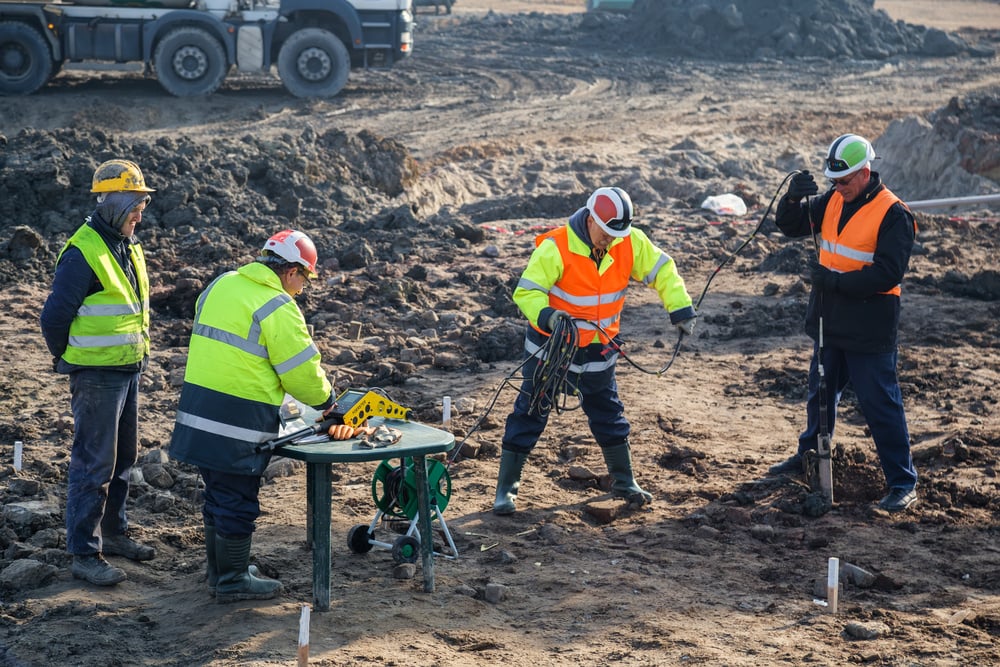The Only Guide for Geotechnical Engineering For Construction Projects
The Only Guide for Geotechnical Engineering For Construction Projects
Blog Article
The smart Trick of Geotechnical Engineering For Construction Projects That Nobody is Talking About
Table of ContentsA Biased View of Geotechnical Engineering For Construction ProjectsThe 9-Minute Rule for Geotechnical Engineering For Construction ProjectsThe smart Trick of Geotechnical Engineering For Construction Projects That Nobody is Talking AboutThe Single Strategy To Use For Geotechnical Engineering For Construction ProjectsGeotechnical Engineering For Construction Projects Things To Know Before You BuyGeotechnical Engineering For Construction Projects Things To Know Before You Get This
The function of geotechnical engineering significantly takes care of understanding the attributes of soil and rock, which may vary considerably by their thickness, moisture content etc. These features need to be checked out by geotechnical designers to anticipate their activities under various scenarios. The safety and security along with stability of frameworks are influenced by dirt problems, making this analysis necessary., in enhancement to how they interact with buildings that have actually been set up on or within them, is one of the key explanations for why geotechnical design is essential.
Along with architectural preparation and building, geotechnical design is likewise essential to the restoration and upkeep of pre-existing structures. Age-related destruction or additional issues can impact a framework's security and efficiency. Ecological security is achieved via geotechnical design. Knowledge in air, water, and dirt quality maintenance is placed to utilize by geotechnical engineers to minimize the negative results of projects.
Framework advancement, offshore engineering, passage construction, and deep structures. Risk-based style and multidisciplinary teams. These elements will certainly maintain the field evolving and ensure its continued importance in the years to come. To sum up, geotechnical engineering is a vital technique that maintains the resilience and integrity of civil framework. Geotechnical designers add to making structure jobs effective throughout the globe by understanding the behaviour of planet materials and using ideal planning methods.
Not known Factual Statements About Geotechnical Engineering For Construction Projects
The fundamental security of any type of job is necessary. Geotechnical design plays an essential duty in making sure that frameworks are improved strong ground, literally and figuratively. By analyzing soil, rock, and subsurface conditions, geotechnical engineers provide essential understandings that assist in the layout, construction, and upkeep of structures and facilities.

More About Geotechnical Engineering For Construction Projects
Research laboratory testing: Figuring out the properties of dirt and rock. A number of top-level building jobs have actually efficiently made use of geotechnical design to guarantee their security and safety.

As a leader in geotechnical engineering, BECC Inc. is dedicated to other providing cutting-edge and reliable remedies that meet the highest possible standards of quality and safety., a mechanical engineer and geologist.
Getting My Geotechnical Engineering For Construction Projects To Work
Terzaghi likewise created the structure for theories of bearing capability of structures, and the theory for prediction of the price of settlement of clay layers because of debt consolidation. Later on, Maurice Biot completely established the three-dimensional dirt loan consolidation theory, extending the one-dimensional design previously created by Terzaghi to extra basic theories and presenting the set of fundamental equations of Poroelasticity.
Geotechnical designers examine and determine the buildings of subsurface conditions and products. They also make equivalent earthworks and preserving frameworks, passages, and framework structures, and might manage and review sites, which may further involve website monitoring as well as the danger analysis and reduction of all-natural threats - Geotechnical Engineering for Construction Projects. Geotechnical designers and design geologists do geotechnical examinations to acquire info on the physical residential or commercial properties of soil and rock underlying and beside a website to create earthworks and structures for suggested structures and for the repair work of distress to earthworks and structures triggered by subsurface conditions.
9 Simple Techniques For Geotechnical Engineering For Construction Projects
Geologic mapping and interpretation of geomorphology are generally completed in appointment with a geologist or engineering rock hound. Subsurface expedition typically includes in-situ screening (for instance, the standard penetration test and cone infiltration test). The digging of examination pits and trenching (specifically for finding mistakes and slide aircrafts) might also be utilized to find out about soil conditions at depth. Still, they are sometimes used to enable a geologist or designer to be lowered right into the borehole for straight aesthetic and manual examination of the site web soil and rock stratigraphy. Different soil samplers exist to meet the requirements of various design tasks. The basic infiltration test, which uses a my link thick-walled split spoon sampler, is the most common way to gather disturbed samples.

Typically, the user interface's precise geometry is unknown, and a simplified interface geometry is thought. Limited slopes require three-dimensional designs to be examined, so most slopes are analyzed thinking that they are definitely broad and can be represented by two-dimensional versions.
The Main Principles Of Geotechnical Engineering For Construction Projects
Creating the design based on a functioning theory of actions prepared for under the most potential conditions. Choice of amounts to be observed as building and construction profits and computing their prepared for values based on the working theory under the most negative conditions.
Measurement of quantities and examination of real problems. Layout adjustment per actual conditions The empirical approach is suitable for building and construction that has already begun when an unforeseen development occurs or when a failing or accident looms or has already happened. It is improper for tasks whose design can not be altered during building and construction.
Report this page